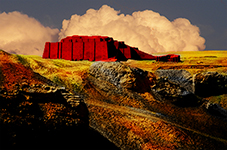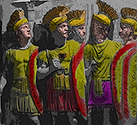




 The success or failure of empires is not easily explained by a single
resource. A gold mine, without the population, markets, or military
resources of a great nation, is little more than a frontier mining town.
Spain, whose fortunes were tied so closely to gold and silver, had an economic and
political base of some depth. Empires required large armies and strong
navies and a fairly substantial agricultural base to fall back on. Athens,
made suddenly wealthy by a silver discovery in 483-2 B.C., quickly converted her
unexpected wealth into a navy, a military resource which could be used to
support other trading opportunities.
The success or failure of empires is not easily explained by a single
resource. A gold mine, without the population, markets, or military
resources of a great nation, is little more than a frontier mining town.
Spain, whose fortunes were tied so closely to gold and silver, had an economic and
political base of some depth. Empires required large armies and strong
navies and a fairly substantial agricultural base to fall back on. Athens,
made suddenly wealthy by a silver discovery in 483-2 B.C., quickly converted her
unexpected wealth into a navy, a military resource which could be used to
support other trading opportunities.
 Spain had laid the foundations for her empire before Columbus even discovered the New World.
Her geographical location on the Atlantic gave her early access to potential new
trading routes. Her military was light years ahead of that of the Aztecs
and Incas and, almost as important, her population had developed an immunity to
diseases, such as measles. Advantages, which were overwhelming in comparison to
the New World, were lost in competition with European rivals. Her military power
was undermined by the advances in weapons and technology adopted by her
opponents. They were immune to the diseases which had wiped out many of the
Indian tribes in the Americas. Spain was no match, in terms of
population. Geography, an advantage in the early days of exploration, now
denied her the economic advantages of North America. If France and
England lost out to Spain in the contest for gold, they more than made up for
that loss with the wealth produced by their colonies to the north.
Spain had laid the foundations for her empire before Columbus even discovered the New World.
Her geographical location on the Atlantic gave her early access to potential new
trading routes. Her military was light years ahead of that of the Aztecs
and Incas and, almost as important, her population had developed an immunity to
diseases, such as measles. Advantages, which were overwhelming in comparison to
the New World, were lost in competition with European rivals. Her military power
was undermined by the advances in weapons and technology adopted by her
opponents. They were immune to the diseases which had wiped out many of the
Indian tribes in the Americas. Spain was no match, in terms of
population. Geography, an advantage in the early days of exploration, now
denied her the economic advantages of North America. If France and
England lost out to Spain in the contest for gold, they more than made up for
that loss with the wealth produced by their colonies to the north.
Resources, some obvious, some less so, have played an important part in the rise and fall of empires. The story of empires may be the story of resources. The opposite may also be true. Insofar as resources have a history to tell, it may well be the story of empires.







